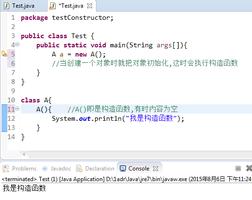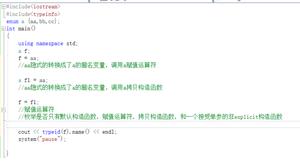嵌套类的构造函数出现问题
这个问题是关于Java的有趣行为的:在某些情况下,它为嵌套类生成了其他(不是默认的)构造函数。
这个问题也与Java使用该奇怪的构造函数生成的奇怪的匿名类有关。
考虑以下代码:
package a;import java.lang.reflect.Constructor;
public class TestNested {
class A {
A() {
}
A(int a) {
}
}
public static void main(String[] args) {
Class<A> aClass = A.class;
for (Constructor c : aClass.getDeclaredConstructors()) {
System.out.println(c);
}
}
}
这将打印:
a.TestNested$A(a.TestNested)a.TestNested$A(a.TestNested,int)
好。接下来,让构造函数A(int a)私有:
private A(int a) { }
再次运行程序。接收:
a.TestNested$A(a.TestNested)private a.TestNested$A(a.TestNested,int)
还可以 但是现在,让我们main()以这种方式修改方法(添加类A创建的新实例):
public static void main(String[] args) { Class<A> aClass = A.class;
for (Constructor c : aClass.getDeclaredConstructors()) {
System.out.println(c);
}
A a = new TestNested().new A(123); // new line of code
}
然后输入变为:
a.TestNested$A(a.TestNested)private a.TestNested$A(a.TestNested,int)
a.TestNested$A(a.TestNested,int,a.TestNested$1)
这是什么: <<< -– ??
好的,让我们再次将构造函数A(int a)包设为本地:
A(int a) { }
再次重新运行程序(我们 带有A创建实例的行!),输出如第一次:
a.TestNested$A(a.TestNested)a.TestNested$A(a.TestNested,int)
如何解释?
第三个奇怪的构造函数是什么?
调查显示如下。
1)让我们尝试使用其他类的反射来调用这个奇怪的构造函数。我们将无法执行此操作,因为没有任何方法可以创建该奇怪TestNested$1类的实例。
2)好的。让我们来解决问题。让我们将TestNested此类静态字段添加到类中:
public static Object object = new Object() { public void print() {
System.out.println("sss");
}
};
好?好的,现在我们可以从另一个类中调用第三个奇怪的构造函数:
TestNested tn = new TestNested(); TestNested.A a = (TestNested.A)TestNested.A.class.getDeclaredConstructors()[2].newInstance(tn, 123, TestNested.object);
抱歉,但我绝对不明白。
进一步的问题是:
为什么Java使用特殊的匿名内部类作为该第三个合成构造函数的参数类型?为什么不只Object键入具有特殊名称的构造函数?
哪些Java可以将已定义的匿名内部类用于这些目的?这不是某种违反安全性的行为吗?
回答:
首先,感谢您提出这个有趣的问题。我很感兴趣,以至于我忍不住要看一下字节码。这是字节码TestNested:
Compiled from "TestNested.java" public class a.TestNested {
public a.TestNested();
Code:
0: aload_0
1: invokespecial #1 // Method java/lang/Object."<init>":()V
4: return
public static void main(java.lang.String[]);
Code:
0: ldc_w #2 // class a/TestNested$A
3: astore_1
4: aload_1
5: invokevirtual #3 // Method java/lang/Class.getDeclaredConstructors:()[Ljava/lang/reflect/Constructor;
8: astore_2
9: aload_2
10: arraylength
11: istore_3
12: iconst_0
13: istore 4
15: iload 4
17: iload_3
18: if_icmpge 41
21: aload_2
22: iload 4
24: aaload
25: astore 5
27: getstatic #4 // Field java/lang/System.out:Ljava/io/PrintStream;
30: aload 5
32: invokevirtual #5 // Method java/io/PrintStream.println:(Ljava/lang/Object;)V
35: iinc 4, 1
38: goto 15
41: new #2 // class a/TestNested$A
44: dup
45: new #6 // class a/TestNested
48: dup
49: invokespecial #7 // Method "<init>":()V
52: dup
53: invokevirtual #8 // Method java/lang/Object.getClass:()Ljava/lang/Class;
56: pop
57: bipush 123
59: aconst_null
60: invokespecial #9 // Method a/TestNested$A."<init>":(La/TestNested;ILa/TestNested$1;)V
63: astore_2
64: return
}
如您所见,构造函数a.TestNested$A(a.TestNested,int,a.TestNested$1)是从您的main方法中调用的。此外,null作为a.TestNested$1参数的值传递。
因此,让我们看一下神秘的匿名类a.TestNested$1:
Compiled from "TestNested.java"class a.TestNested$1 {
}
奇怪-我本来希望这堂课能真正做些事。要了解它,让我们看一下a.TestNested$A:类a.TestNested $ A {final
a.TestNested this $ 0;
a.TestNested$A(a.TestNested); Code:
0: aload_0
1: aload_1
2: putfield #2 // Field this$0:La/TestNested;
5: aload_0
6: invokespecial #3 // Method java/lang/Object."<init>":()V
9: return
private a.TestNested$A(a.TestNested, int);
Code:
0: aload_0
1: aload_1
2: putfield #2 // Field this$0:La/TestNested;
5: aload_0
6: invokespecial #3 // Method java/lang/Object."<init>":()V
9: return
a.TestNested$A(a.TestNested, int, a.TestNested$1);
Code:
0: aload_0
1: aload_1
2: iload_2
3: invokespecial #1 // Method "<init>":(La/TestNested;I)V
6: return
}
查看包可见的构造函数a.TestNested$A(a.TestNested, int, a.TestNested$1),我们可以看到第三个参数被忽略了。
现在我们可以解释构造函数和匿名内部类。为了避免对私有构造函数的可见性限制,需要额外的构造函数。这个额外的构造函数只是委托给私有构造函数。但是,它不能具有与私有构造函数完全相同的签名。因此,添加了匿名内部类以提供唯一的签名,而不会与其他可能的重载构造函数发生冲突,例如带有署名(int,int)或的构造函数(int,Object)。由于仅需要此匿名内部类来创建唯一的签名,因此不需要实例化它,也不需要具有内容。
以上是 嵌套类的构造函数出现问题 的全部内容, 来源链接: utcz.com/qa/397873.html









